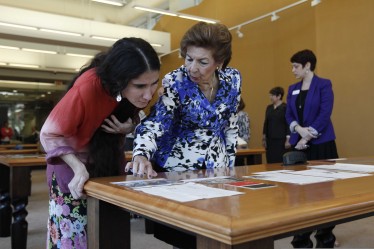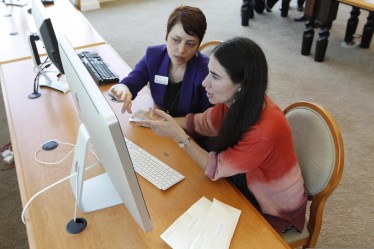
Yoani Sánchez (left) looks at some of the Cuban Heritage Collection’s most important holdings, as CHC director Esperanza Bravo de Varona explains the significance of the materials.
A meeting with journalists and a visit to Miami’s Freedom Tower already behind her, Cuban dissident blogger Yoani Sánchez stepped into the lobby of the University of Miami’s Cuban Heritage Collection (CHC) and paused, looking around at the glass display cases and paintings.
“Este es un lugar muy bonito, es un lugar excepcional (This is a very beautiful place. It is an exceptional place),” said Sánchez, who arrived in Miami on March 28 to spend time with family before starting a public agenda.
On April 2 that agenda brought her to UM, where, accompanied by President Donna E. Shalala and other dignitaries, she toured one of the world’s largest repositories of books, manuscripts, maps, letters, and other materials on Cuba and the Cuban Diaspora from colonial times to the present. UM trustee Carlos M. de la Cruz, Sr.; Executive Vice President and Provost Thomas J. LeBlanc; Sergio Gonzalez, senior vice president for university advancement and external affairs; and Rudy Fernandez, vice president for government affairs also accompanied Sánchez. She asked to visit the CHC, which is housed on the second floor of UM’s Otto G. Richter Library.

Sánchez gets a tutorial from María Estorino, CHC deputy chair and chief operations manager, on how to search for materials in the repository’s extensive digital archives.
The Cuban blogger looked at two rare newspapers that showed the diversity and length of the Cuban Diaspora: Acción Cubana, published by Cuban exiles in Luxembourg in 1959, and Éxodo, a newsletter published by Cuban detainees in Guantánamo during the Cuban rafter crisis of the mid-1990s.
Sánchez also sat at a computer terminal to review the CHC’s extensive digital collection. She viewed the collections page, learning how users conduct searches of the archives. She was shown images from the Cuban Refugee Center Records and was given ten flash drives, five of them loaded with a selection of materials from the CHC’s digital collections and another five loaded with four interviews from the more than 100 that are part of its Luis J. Botifoll Oral History Project.
Esperanza Bravo de Varona, the longtime UM librarian and head of the CHC, called Sánchez’s visit historic. “When she leaves, she will have the knowledge of our collections and what they mean to Cubans and Cuban Americans and the reality of what Cuba has been before, during, and probably after Castro.”
The 37-year-old Sánchez has become famous in the blogosphere for her blog Generation Y, which gets more than 15 million hits a month and is translated into 20 languages. As many as 500,000 people follow her on Twitter. Many of her postings are critical of the Castro government and human rights violations on the island.
Her visit to UM followed an emotionally charged appearance at Miami’s Freedom Tower on April 1, when she spoke to a crowd of mostly Cuban exiles and Cuban-Americans, telling them not to allow anyone to divide them as a community. She said that Cuban exiles would be needed in the post-Castro era. She finished her April 1 agenda at Florida International University, where she spoke on how information technology is accelerating change in Cuba.

After her tour of the CHC, Sánchez met with University of Miami students for a discussion that ranged from the blogger’s passion for technology to how those in the exile community can help Cubans back home.
The Cuban journalist has been on a whirlwind tour that has taken her from Rio de Janeiro to Mexico City, Prague, New York, and Washington, D.C. She was scheduled to depart Miami on April 4 to return to Europe. Her plans call for her to return to Cuba in mid-May.
After reviewing some of the CHC’s collections during her UM visit, Sánchez met with a group of University of Miami students in the Roberto C. Goizueta Pavilion conference room, discussing topics ranging from her passion for technology to how those in the exile community can help Cubans back home.
Students from The Miami Hurricane newspaper, WVUM, UMTV, and other parts of the University listened as Sánchez told them that she is a trained “philologist” and that she has always been drawn to journalism. Her “passion for the new technology” won her over, she said.
“Even though I am not a journalist by profession, I have become a journalist on the run,” she said. “It is a profession that I greatly value. No wonder José Martí, the man who represents the best of the Cuban nation, practiced journalism so masterfully.”
She explained that Cubans in the exile community could help Cubans on the island by practicing journalism with greater depth, eschewing stereotypes. She said that in her travels she is often approached by people, who, upon learning that she is Cuban, often say, “Oh, you are Cuban. You people are poor but happy.”
She said there is a responsibility to delve beyond these stereotypes and to give a broader and deeper picture of Cubans. Another way of helping the Cuban people is by sending them memory sticks, old cell phones, or even a current newspaper or magazine.
“I have a friend who called me to say that he is flying in from Madrid and wants to know what to bring me,” she said. “And I say, ‘Bring me the daily newspaper.’ To me it is like a breath of fresh air to receive a newspaper. It is oxygen.”
Sánchez concluded her trip with a visit to UM’s Institute for Cuban and Cuban-American Studies.










